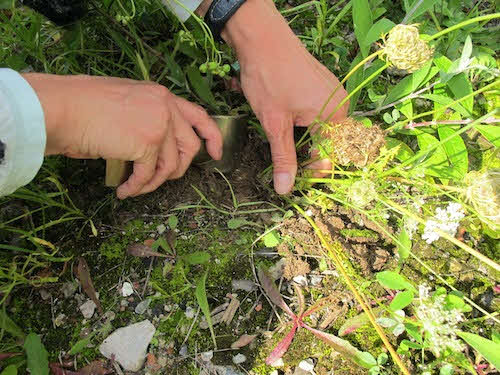The art of foraging goes back to our hunter-gatherer days, but most of us don’t spend much time any more walking the neighborhood looking for edible weeds and fruit trees.
That’s changing, though, as many try to simplify and take advantage of food that’s available for the taking in our yards, parks, and other green spaces. It’s also a way to save a little grocery money if you really want your family to eat well, but are also looking for ways to cut expenses.

But where do find these tasty treasures? Sure, weeds will spring up with the change in seasons, but how about an apple tree? A mushroom patch (that’s safe for eating)? Way back in the days before the web, I’m sure there must’ve been word-of-mouth networks for foragers; now, there are crowdsourced maps online that anyone can use to find fruit, nuts, greens, and other wild goodies.
Related Post: Winter Foraging: 20+ Edible Greens, Nuts, Seeds, and Fruits to Forage For in Cold Weather
After digging around for a while, I’ve discovered these eleven online maps that allow foragers to not only take advantage of bounty that others have discovered, but to also share their finds. Most use Google Maps, so you only need a Google account to participate fully in the hunt for wild edibles.
11 Crowdsourced Maps for Urban Foraging
- Falling Fruit: I don’t know if FallingFruit.org is the oldest of foraging maps, but it’s definitely among the most thorough: many cities around the US and the rest of the world are represented here (yes, even us, St. Louis!).
- Edible Cities: Another mega-map, Edible Cities requires just a bit more understanding of Google Maps (because they don’t appear to have a separate index of locations).
- Fruits of the Hood: A much more modest effort than those above, but one that’s working, Fruits of the Hood started in Raleigh, North Carolina, and now has edibles mapped in a variety of Southeastern locations (as well as Pennsylvania and Oregon).
- Urban Edibles: Focused on Portland, Oregon, this “cooperative network of wild food foragers” has spread beyond the city limits, and even up to Seattle.
- Canberra Urban Foraging: This very focused map shares locations of wild edibles, fruit trees, etc., in Canberra, Australia.
- Hackney Harvest: Even more focused, this fruit tree map focuses on London’s Hackney borough. Submissions to this one have to go through the administrators.
- Boise’s Urban Foods Map: And just in case you’re thinking this is purely a Coastal hipster thing, here’s a map of forageable plants in Boise, Idaho…
- Boskoi Urban Edibles App: Sure, you can pull up Google Maps on your phone… or you can download Boskoi, an app specifically for foraging. This Android app was developed in Amsterdam, so there’s a definite European focus in the finds.
- Street Fare: Focused on Santa Monica, California, this map is organized around species of fruit and nut trees.
- Denver Fruit Map: The developers here went one step further and created original markers that look like the fruits themselves. There’s also a companion map for Boulder.
- New Zealand Fruit and Food Share Map: For Kiwi foragers, here’s a map of “under-utilised food” around the country.
I went with what I found through some focused searching, but no doubt missed some good resources. If you know of others, let us know about them.









































For people who can read German (or at least interpret pictograms), there’s Mundraub.org
For obvious reasons, the map mainly covers central Europe at the moment, but a few people from the UK and the US have also started using the map. You don’t need a Google account.
http://mundraub.org/map
Thanks for sharing that, Vivi… I pulled it up in Chrome, and everything translated nicely, so you don’t have to read German!
Jeff, just found your site via an rss feed.
Have you heard of the Incredible Edible Todmorden in the UK? a couple of links follow for you to browse
http://www.incredible-edible-todmorden.co.uk/
http://www.theecologist.org/green_green_living/2202429/incredible_edible_todmorden.html
I haven’t, Vivienne, but I’ll dig into it… looks like something right up my alley!
Really interesting Jeff, thanks!
I think that you would be really interested in some of the most cutting-edge research that I have come across explaining crowds, open innovation, and citizen science.
http://papers.ssrn.com/sol3/cf_dev/AbsByAuth.cfm?per_id=1919614
And you may also enjoy this blog about the same too:
https://thecrowdsociety.jux.com/
Powerful stuff, no?
Definitely – this all looks fascinating! I will dig into it…
Hi, I’m BRAND new to foraging and I am in St Louis. I need a rather simple question answered but can’t seem to resolve this. The Missouri State Parks site says to never remove plants from their parks. Yet I read all kinds of articles about the wonderful plants you can find in Missouri, and references to the trails around St. Louis. When I arrive at a trail or natural area in Missouri, how do I know whether the state is okay with me foraging there? Thanks for your insights.
You need to go look at the specific park rules. I’m in the St Louis area, but there are several parks nearby where they ask you to be nice when foraging or say not to remove plants in certain sections.
Hi Jeff, have you had a look at iplantz.com?